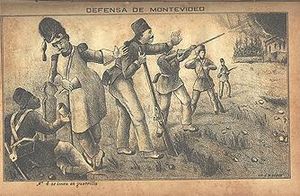Great Siege of Montevideo
(Redirected from )
This article may be expanded with text translated from the corresponding article in Spanish. (April 2013) Click [show] for important translation instructions.
|
| Great Siege of Montevideo | |||||||
|---|---|---|---|---|---|---|---|
| Part of the Uruguayan Civil War and the Platine War | |||||||
 | |||||||
| |||||||
| Belligerents | |||||||
|
Besiegers: Supported by: |
Besieged: Supported by: | ||||||
| Commanders and leaders | |||||||
|
|
| ||||||
| Strength | |||||||
|
1843:[1] 1848:[2] 1851:[3][4] |
1843:[1][5][6] 1851:[7][8][9](Reinforcements) | ||||||
The Great Siege of Montevideo (Spanish: Gran Sitio de Montevideo), named as Sitio Grande in Uruguayan historigraphy, was the siege suffered by the city of Montevideo between 1843 and 1851 during the Uruguayan Civil War.[10]
In practice, this siege meant that Uruguay had two parallel governments:
- Gobierno de la Defensa in Montevideo, led by Joaquín Suárez (1843 – 1852)
- Gobierno del Cerrito (with headquarters in the present-day neighborhood of Cerrito de la Victoria), ruling the rest of the country, led by Manuel Oribe (1843 – 1851)
The siege inspired a book by the French writer Alexandre Dumas, The New Troy (1850).
See also[]
References[]
- ^ a b Rela 1998, pp. 64 and 91.
- ^ Casas 2005, p. 255.
- ^ Solari 1951, p. 146.
- ^ Saldías 1978, p. 15.
- ^ Granaderos - Historial. Cronología 1835-1846
- ^ Núñez 1979, p. 3.
- ^ Salgado 1943, pp. 7.
- ^ Levene 1939, pp. 96.
- ^ Walter Rela (1998). Uruguay: República Oriental del Uruguay, 1830-1864. Montevideo: ALFAR.
Bibliography[]
- Bruce, George Harbottle (1981). Harbottle's Dictionary of Battles. Van Nostrand Reinhold. ISBN 0-442-22336-6
- Casas, Lincoln R. Maiztegui (2005). Orientales: una historia política del Uruguay (in Spanish). Montevideo: Planeta.
- Levene, Ricardo (1939). Historia de la nación argentina: (desde los orígenes hasta la organización definitiva en 1862) (in Spanish). Buenos Aires: El Ateneo.
- McLean, David (1998) Garibaldi in Uruguay: A Reputation Reconsidered Vol. 113, No. 451. The English Historical Review. (Apr., 1998), pp. 351–66.
- Núñez, Estuardo (1979). Tradiciones hispanoamericanas (in Spanish). Caracas: Fundación Biblioteca Ayacucho. ISBN 84-660-00-28-3
- Rela, Walter (1998). Uruguay cronología histórica anotada: República Oriental del Uruguay 1830-1864 (in Spanish). Montevideo: ALFAR. ISBN 99-743-91-73-3
- Sahuleka, Daniel; Navia, Vicente (1886). Compendio cronológico de historia universal por Mor. Daniel (in Spanish). Impr. de El Laurak-Bat.
- Saldías, Adolfo (1978). Historia de la Confederación Argentina. Tomo III (in Spanish). Buenos Aires: EUDEBA, Editorial Universitaria de Buenos Aires.
- Salgado, José (1943). Historia de la República Oriental del Uruguay. Tomo VIII (in Spanish). Montevideo: Tallares A. Barreiro y Ramos.
- Solari, Juan Antonio (1951). De la tiranía a la organización nacional: Juan Francisco Seguí, secretario de Urquiza en 1851 (in Spanish). Buenos Aires: Bases.
| Wikimedia Commons has media related to Great Siege of Montevideo. |
Categories:
- Uruguayan Civil War
- Sieges
- History of Montevideo
- 1843 in Uruguay
- 1851 in Uruguay
- 19th century in Montevideo
- Sieges involving Brazil
- Uruguayan history stubs
- Siege stubs
- Montevideo stubs